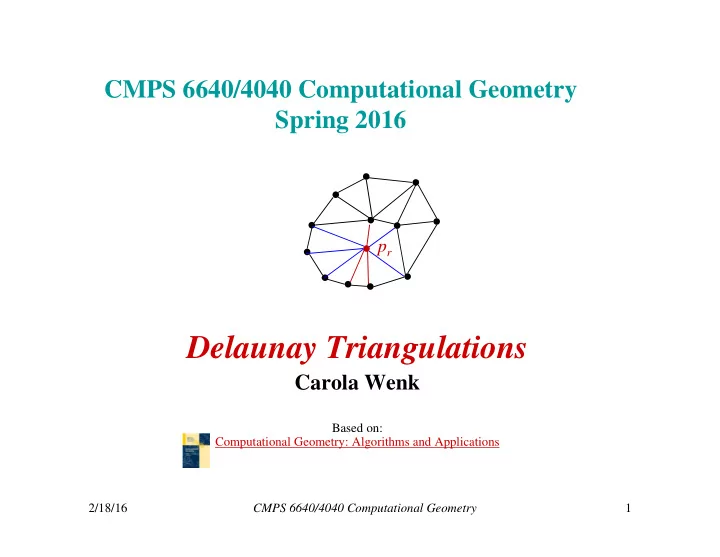

CMPS 6640/4040 Computational Geometry Spring 2016 p r Delaunay Triangulations Carola Wenk Based on: Computational Geometry: Algorithms and Applications 2/18/16 CMPS 6640/4040 Computational Geometry 1
Applications of DT All nearest neighbors: Find for each p P its nearest neighbor q P ; q p . • p Empty circle property: p,q P are connected by an edge in DT( P ) – there exists an empty circle passing through p and p . Proof: “ ”: For the Delaunay edge pq there must be a Voronoi edge. Center a circle through p and q at any point on the Voronoi edge, this circle must be empty. “ ”: If there is an empty circle through p and q , then its center c has to lie on the Voronoi edge because it is equidistant to p and q q and there is no site closer to c . Claim: Every p P is adjacent in DT( P ) to its nearest neighbor q P . – p q Proof: The circle centered at p with q on its boundary has to be empty, so the circle with diameter pq is empty and pq is a Delaunay edge. – Algorithm: Find all nearest neighbors in O( n ) time: Check for each p P all points connected to p with a Delaunay edge. • Minimum spanning tree: The edges of every Euclidean minimum spanning tree of P are a subset of the edges of DT( P ). 2/18/16 CMPS 6640/4040 Computational Geometry 2
Randomized Incremental Construction of DT(P) • Start with a large triangle containing P . • Insert points of P incrementally: – Find the containing triangle – Add new edges – Flip all illegal edges until every edge is legal. 2/18/16 CMPS 6640/4040 Computational Geometry 3
Randomized Incremental Construction of DT(P) p r p r • An edge can become illegal only if one of its incident triangles changes. • Check only edges of new triangles. • Every new edge created is incident to p r . • Every old edge is legal (if p r is on on one of the incident triangles, the edge would have been flipped if it were illegal). • Every new edge is legal (since it has been created from flipping a legal edge). 2/18/16 CMPS 6640/4040 Computational Geometry 4
Pseudo Code 2/18/16 CMPS 6640/4040 Computational Geometry 5
History The algorithm stores the history of the constructed triangles. This allows to easily locate the triangle containing a new point by following pointers. • Division of a triangle: Store pointers from the old triangle to the three new triangles. • Flip: Store pointers from both old triangles to both new triangles. 2/18/16 CMPS 6640/4040 Computational Geometry 6
Recommend
More recommend